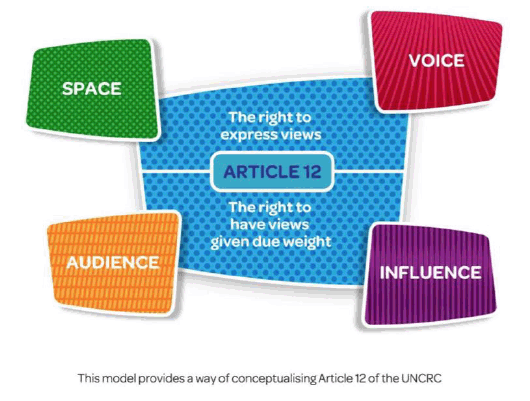Can Scotland be Brave – Incorporating UNCRC Article 12 in practice
This project investigated how well practitioners, understood and implemented the full obligations of Article 12 of the United Nations Convention on the Rights of the Child (‘UNCRC’).
A Creative Approach – Talking Mats© and the Lundy Model
Some CYP find it hard to engage with standard conversations. In order to be inclusive, we used Talking Mats. Talking Mats is as a way of changing conversations because it opens up topics, helping staff to have a fresh understanding of the CYP's life.
Why use Talking Mats?
Talking Mats is an evidence based interactive picture communication tool. The 'mat' provides a space for the conversation – a place to put thoughts down.
There are three sets of picture communication symbols – topics (whatever you want to talk about), options (relating specifically to the topic), and a visual scale (to allow participants to indicate their feelings about each option).
Once the topic is identified, the participant (the 'thinker') is given the options one at a time and asked to think about what they feel about each one. They can then point or place the symbol under the appropriate visual scale symbol to indicate what they feel. The practitioner's role in the Talking Mat is to be a 'listener'. Training the listener is key to ensuring that proven principles are adhered to, such as using open questions, being non-judgemental and reviewing the mat.
Why does Talking Mats work?
It improves the quality of information by:
- Giving control to the thinker
- Providing a structured framework for open questions
- Avoiding direct confrontation
- Giving people time
- Helping people to say "no"
It supports comprehension by:
- Focusing on the essential words and omitting non-essential language – reducing language demands
- Giving information in multiple channels – visual, auditory and tactile. Literacy skills are not needed
- Helping people process concepts by breaking information down into small, manageable chunks, moving from concrete to more abstract ideas
- Reducing memory demands: the mat acts as the working memory
- Reducing distractibility
- Allowing time for processing information
The resource can be adapted to age and stage of development. The technique has been developed through clinical experience (Speech and Language Therapists working within the NHS) and a programme of robust research at Stirling University over a 15-year period.[16] The technique is used by practitioners in Scotland, the rest of the UK and worldwide.
The Lundy Model of Participation
In order to help CYP make informed choices and decisions there is a developmental progression, from learning how to voice an opinion to sharing the responsibility for making a decision.
In 2001, Harry Shier's model of participation was influential in helping practitioners to understand this progression. He outlined five increasing levels of engagement, depending on the weight given by adults when taking views into account. These are:
1. Children are listened to.
2. Children are supported in expressing their views.
3. Children's views are taken into account.
4. Children are involved in the decision-making processes.
5. Children share power and responsibility for decision-making.
In 2007, Laura Lundy expanded on this idea by publishing an influential paper entitled "Voice is not enough"[17] and developed the Lundy model of participation[18] to help practitioners to understand the full obligations of Article 12. In order to do this, she also included the other relevant Articles in the convention: 2,3,5, 13 and 19:
"the meaning of individual provisions of the UNCRC can only be understood when they are read and interpreted in conjunction with the other rights"15
She identified four distinct, but interrelated elements of Article 12 as illustrated in Figure 2 below:
- Space: Children must be given the opportunity to express a view
- Voice: Children must be facilitated to express their views
- Audience: The view must be listened to
- Influence: The view must be acted upon, as appropriate

Figure 2 Description
This model illustrates what needs to be done by practitioners in order to fulfil the obligations of Article 12 of the UNCRC. The picture has a rectangle in the middle which is Article 12 UNCRC and on each of the four corners there are four boxes. The four boxes show the four elements that must be included, mainly: Space Voice, Audience and Influence
It is not enough for us to merely capture the views of children: we must also inform them as to how their views have been considered and provide clear feedback on how their participation will influence outcomes. They should also be given the opportunity to participate in follow-up processes and/or activities.
The Lundy model and checklist were selected for use in the project because it provides a clear structure for practitioners and allows them to demonstrate change in their practice.
Contact
Email: Charles.laing@gov.scot
There is a problem
Thanks for your feedback